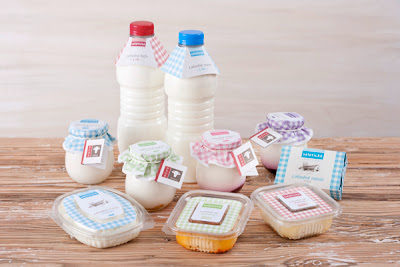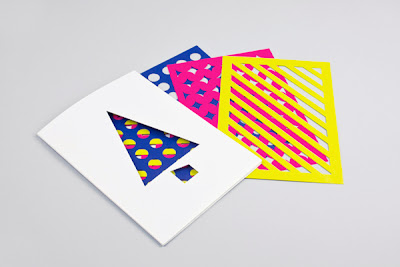TASK
With a focus on stock, substrate & 'special' print processes, find as many variants as possible for each of these areas:
Branding & Identity
Packaging & Promotion
Publishing & Editorial
Information & Wayfinding
Wherever possible, you should aim to collect physical examples of print as this will help with evaluation.
Definitions of Processes
I chose to research and define each process before looking at them.
Coated Stock / Uncoated Stock
Coated paper
Coating is a process by which paper or board is coated with an agent to improve brightness or printing properties. By applying PCC, china clay, pigment or adhesive the coating fills the miniscule pits between the fibres in the base paper, giving it a smooth, flat surface which can improve the opacity, lustre and colour-absorption ability. Various blades and rollers ensure the uniform application of the coating.Different levels of coating are used according to the paper properties that are required. They are divided into light coated, medium coated, high coated, and art papers - art paper is used for the high quality reproduction of artwork in brochures and art books.
Uncoated paper
Not all paper is coated. Uncoated paper is typically used for letterheads, copy paper, or printing paper. Most types of uncoated paper are surface sized to improve their strength. Such paper is used in stationary and lower quality leaflets and brochures.Die Cut
Die cutting is the process of using a die to shear webs of low-strength materials, such as rubber, foil, cloth, paper, plastics, foam and sheet metal.
UV Coating
UV coating is basically a compound that is applied to paper wet and then instantly dried by ultraviolet light. Several different types of compounds are used to coat paper, including polyethylene, calcium carbonate and kaolinite. UV coatings can vary in reflectivity and thickness, depending on the application, though a high gloss or subtle matte are typically used in premium printing applications.
Just about anything can be UV coated, though it is worth noting that UV coating typically works best on thicker paper stocks. This means that business cards, postcards, posters, letterheads etc, can have UV applied to them.
Emboss / Deboss
When pressure is applied to either push stock down to create an outline (deboss), or upwards to create a ridge (emboss).
Duplex
Essentially printing double sided.
Foiling
A way of applying a reflective / thin coat to give an extra finish to stock. This is available in a variety of forms, such as different colours, metallics (eg. gold, silver, copper), as well as Holofoil, a reflective and colourful effect.
Branding & Promotion
Coated Stock
On the below branding project, it is clear the designer has selected a coated stock. This is so a much more vivid colour can printed, with sharper lines. A considerable of cyan and magenta ink has been used, which would be soaked up by an uncoated stock. This would result in the 'Hawker' logo to appear far less sharp.
Uncoated / Coated Stock
The below project shows both coated and uncoated stock. The business card uses an uncoated stock, to allow the stamp to print easily and in a solid colour, this also being the same on the screen printed mailshot. However, the letterhead has been printed on a coated stock, as it is cheaper, thus better for mass production.
Spot Varnish has been used here to add a subtle second layer to the work. This works great on a business card, as it gives the card much more value, making it harder to want to throw away. The use of spot varnish also showcases the studios ability to work with a range of processes.
Product & Packaging
Uncoated Stock
Here an uncoated stock has been used to give the packaging a less corporate look. The yoghurts have been designed to look short run and home made, which is emphasized by the use of non coated stock. The use of this stock also makes the colours slightly more dull. given the product an almost 'worn' look/
Die Cut
I really like the project below. It is essentially a customizable Christmas card, where changing the layers of stock allows the user to interact and adapt the card. Obviously these patterns would be far too time consuming to produce by hand, and the same with laser cutting. Die cut was used, and is the best solution for mass production, and also achieving a high profit margin.
Editorial & Publishing
Die Cut
Here you can see how Die Cut has been used throughout a publication. The use of circles is a reoccurring theme, and circles are notoriously hard to cut by hand. Die cutting has been used to give a clean edge, that fits in with the equally as sharp typography.
Information & Wayfinding
Deboss
The use of debossing here is not just for aesthetic reasons, but also for functionality. The idea of this calendar is to fill on days with a colour coding, recording how well your day has been. Debossing allows you to colour in each hexagon much easier, resulting in a tidier calendar.
Summary of Processes and Design Fields
From looking at different processes and design fields, I have come to different conclusions about different areas.
Branding & Identity - The area of design which seems to showcase various methods of formats and finishes the most. I think this is because studios like to show off that they are capable at using them. If the work is for a non - design agency client, these processes are used tot just add a touch of class to a brand. It is common to see foiling used with a high end client. The same can be said for stock. I have noticed that normally quite high end branding is printed on an uncoated stock. Coated stock can be considered as quite cheap, with very little or no texture to it.
Editorial & Publishing - Unlike branding and identity, formats and processes are less common. They are equally as common and varied in terms of from and back covers, but usually the internal design of books is kept simple with no fancy processes. When different finishes are used on the outside of a publication, it can add a dimension which may attract viewers to read. 'You only judge a book by it's cover'. Generally, a coated stock is used with publications. This is because the ink sits on top, giving body text a much sharper look, adding to functionality.
Product and Packaging - A range of processes are used in this, mainly die cut (when using card as a net for packaging). However, popular processes include: spot varnish, foiling and even occasionally screen printing. Generally the more a product is mass produced, the less formats and finishes are used.
Information & Wayfinding - Out of all the areas above, this area seems to be the least experimental with processes. I think this is due to the subject being highly functional, and can be taken for granted. People do not seem to appreciate the use of different processes as much as other areas. Generally, things that are designed for this area have a functional purpose, not to please the eye.

























